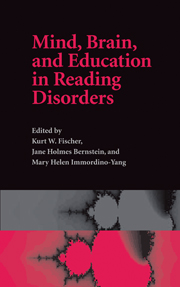Book contents
- Frontmatter
- Contents
- List of figures
- List of tables
- List of contributors
- Acknowledgements
- Part I What is Reading, and What are Reading Disorders? Looking to Neuroscience, Evolution, and Genetics
- 1 Toward a grounded synthesis of mind, brain, and education for reading disorders: an introduction to the field and this book
- 2 An evolutionary perspective on reading and reading disorders
- Essay: Brain volume and the acquisition of adaptive capacities
- 3 The genetics of dyslexia: what is the phenotype?
- Part II Reading and the Growing Brain: Methodology and History
- Part III Watching Children Read
- Part IV Reading Skills in the Long Term
- Appendix: Transcript and behavioral data from Profiles in Reading Skills (Four Boys)
- Index
- References
3 - The genetics of dyslexia: what is the phenotype?
Published online by Cambridge University Press: 22 September 2009
- Frontmatter
- Contents
- List of figures
- List of tables
- List of contributors
- Acknowledgements
- Part I What is Reading, and What are Reading Disorders? Looking to Neuroscience, Evolution, and Genetics
- 1 Toward a grounded synthesis of mind, brain, and education for reading disorders: an introduction to the field and this book
- 2 An evolutionary perspective on reading and reading disorders
- Essay: Brain volume and the acquisition of adaptive capacities
- 3 The genetics of dyslexia: what is the phenotype?
- Part II Reading and the Growing Brain: Methodology and History
- Part III Watching Children Read
- Part IV Reading Skills in the Long Term
- Appendix: Transcript and behavioral data from Profiles in Reading Skills (Four Boys)
- Index
- References
Summary
Overview: Dyslexia has a genetic basis, but a major question is the developmental relation between genes and behaviors, especially complex, culturally mediated behaviors such as reading. Moreover, because the dyslexic behavioral and anatomical phenotypes are still debated, interpreting correlations between brain and behavior is difficult. Using research involving animal models, postmortem studies of dyslexics' brains, and genetic studies of dyslexics' families, Galaburda and Sherman attempt to isolate genotypes and phenotypes for dyslexia. The research illuminates genetic differences between dyslexics and normals, as well as the low-level cognitive, sensory, and perceptual correlates of these differences. The authors focus especially on the functional and anatomical implications of ectopias, small malformations of the cortex resulting from altered neuronal migration during fetal development. Certain kinds of ectopias have been associated with dyslexia and could represent a basic, genetically influenced abnormality that through development may relate to important characteristics of dyslexics.
The EditorsAttempts to relate specific genes to specific human cognitive functions have not revealed any genes that control cognitive behavior in humans. We do not know, for instance, what the genetic basis for language in humans is, and why it is, genetically speaking, that even our closest relative – the chimpanzee – does not have anything approximating human language, even though we share over 95 percent of our genes with this species. This state of affairs, after 150 years of neurological research on language, and nearly 50 years since the discovery of the genetic code, should not be surprising.
- Type
- Chapter
- Information
- Mind, Brain, and Education in Reading Disorders , pp. 37 - 58Publisher: Cambridge University PressPrint publication year: 2007
References
- 1
- Cited by



